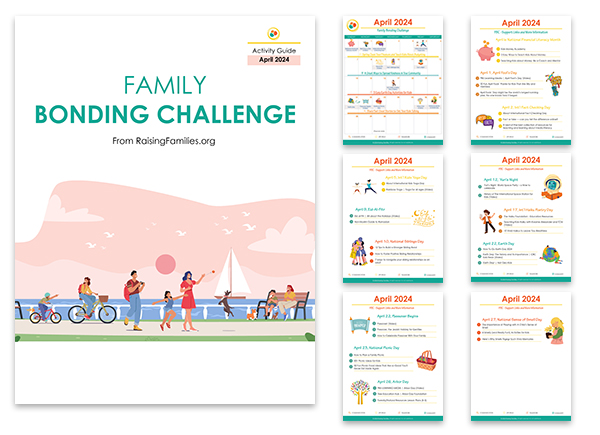- Home
- »
- Family Bonding Challenge
- »
- Spring Clean Your Finances...
Spring Clean Your Finances and Teach Kids about Budgeting

Age: 7+
Time: at least 20 to 30 minutes for discussion portion
Materials: paper and pen
Focus: life skills and creating a budget
Spring is here. For some of us that means cold and flu season is turning into allergy season. For others, your instincts are telling you it’s time to stop hibernating and start sorting and cleaning out your closets. You may not be thinking this is the perfect time to gather the troops to teach kids about budgeting and bond as a family team while doing so. Surprise! It is a great time, actually.
As we thaw out from winter, opportunities to open our wallets and splurge on new clothes, seasonal festivals, amusement parks, restaurants, and so much more start appearing around every turn or, more likely, swipe of the finger.
It’s tempting to want to spend all day every day when you’re not trapped indoors anymore. But we know that’s a recipe for disaster. Your family budget still exists, whatever the temperature outside.
So whether or not you scratch the seasonal itch of decluttering your home, you can take the opportunity to spring clean your finances and teach kids about budgeting to make room for all the fun new activities, wardrobe additions, and seasonal necessities.
Even if your kids are little, if they have a basic understanding of numbers, you can start teaching financial literacy by talking about money in terms that will make sense to them (i.e., cost of toys).
Once there’s a basic understanding of money, you can start to teach kids about budgeting by talking about where the family money comes from and why the family spends money on certain things and not others. This is a great opportunity to discuss the family values that impact your spending habits.
Teach Kids about Budgeting by Reviewing Family Finances
1. At your next family meeting, go over the family budget to talk about where the money goes.
Start with the fixed basic necessities like your mortgage or rent, car payment or other regular transportation costs, and monthly groceries. Utilities, insurances, various tuition payments, allowances, savings accounts … all the things that you can think of that have a regular monthly cost should be included.
Depending on the age of your child, you can actually identify the exact amounts you spend or just make a list of the expenditures. Your six- or seven-year-old might actually stay engaged in the conversation if you have them show off their math skills by doing the subtraction work for everyone to see how the money gets spent.
2. Have a quick talk about wants and needs.
Before discussing ways to change the budget, make sure your kids have a solid understanding of the difference between wants and needs. It will help them understand what is a negotiable in the overall list of things you spend money on.
From the list you made in step one, identify which are wants (camps, classes, meals out, etc.). Follow up with which ones are needs (clothing, shelter, transportation, etc.).
3. Set a goal for your savings.
As you go over the family spending, talk about things the family could do with a little extra money. The discussion might result in an idea for a family vacation or the desire for a new toy.
It’s absolutely normal if the kids show more interest in finding money for something they want personally rather than something for the whole family. They’re making the conversation personal and relevant to them. That’s absolutely normal when you teach kids about budgeting.
The point here is to create a reason to pack a lunch instead of buying one or to make coffee at home instead of heading to a coffee shop. We all feel motivated to contribute when there’s a reason.
4. Looks for ways to save.
See if anyone can think of immediate areas to save. If nothing jumps out, do a seasonal evaluation of major expenditures that fall under the “wants” category.
Does kiddo number one still enjoy gymnastics class or is it just a habit now? That money could go elsewhere. Does kiddo number two want to do baseball again or will these next few months be about discovering new music and local hiking trails? Is anybody actually using the gym membership?
It’s possible nothing may change in those large expenditure categories. That’s a lesson on priorities that is worthwhile all on its own.
From there, look at smaller areas of spending. If your family normally eats out several times a week, maybe everyone would like to pitch in to help make dinner on one of those nights instead.
If all you’re getting is blank stares from the kids, offer some personal items you’re willing to go without for a while. Giving up your avocado toast and lattes won’t save enough for a down payment on a new house, but for a few months it could help you toward a smaller goal.
If Needed, Add Money to the Budget
Maybe the family’s happy with the budget or there just isn’t wiggle room to change where the family money goes. That’s okay. The next step in teaching kids about budgeting is to find ways to add money to the overall pot.
You’ve spring cleaned your budget. Now you might actually have a reason to spring clean your home.
1. Sell your clutter online.
Most likely there are things lying around the house that can be sold. Think about workout equipment that has become another place to hang things. Try posting it on Facebook Marketplace, eBay, or contacting a local reseller.
Maybe you have belongings (bikes, game consoles, tablets, etc.) that are still in decent condition but are no longer used or played with. If the family sells these, you’ll be decluttering your way to family fun!
Having a family activity or wish list you’re working toward is also a great way to keep the whole family motivated.
Used clothes can be sold online in tons of different ways.
2. Get a job.
If there isn’t anything around the house to sell, get the family brainstorming on jobs that can be done in the neighborhood to earn a little extra money. Maybe the kids can help a neighbor do some yard work.
This isn’t a place to suggest Mom or Dad get a second job but to help tweens and teens think outside the box on what they can do to help add to the family finances.
Keep Track of the Budget
However money is added to the family’s budget (or perhaps just a temporary extra money fund), have the kids help keep track of how much they have to work with.
You can use an app or have them write down the amount that’s put in each time money is added and the running total.
Teaching kids about budgeting is partly about the numbers of saving but also about the numbers of spending. Help your kids do some research about the cost of what they want the money to be spent on.
If the family is saving for an outing to the movie theater, have them find out the cost of tickets. Will the family be having popcorn and soda or other concessions? If so, how much will all of that be? Have them figure out the total amount needed for the outing.
When the extra money fund reaches that amount, it’s time to enjoy the benefits of everyone’s hard work. Have the kids keep track of what’s actually spent and see how close they came to budgeting correctly. This is a good time to have a cash day.
If the family decided to save up for a vacation or something more extravagant than a family outing, you’ll need to support the kids more with planning and figuring out details. Just make sure you keep them in the loop and involve them in the planning process, so they can learn what goes into budgeting for a larger expenditure.
After you’ve reached the family’s goal, it’s time to reevaluate and see if the family wants to continue with the same budget and start saving for something new or readjust the family budget again.
Whatever your family decides, you’ll have taken a step to teach kids about budgeting while creating some family memories.
Join the Community!

Get Excited About Your Future
Delight your inbox with monthly lessons carefully chosen to help you grow as a proactive parent who's always looking to learn more about raising a strong family team.

Monthly Live Engagement
Join our monthly live chats to discuss each month's topic in-depth and get all your questions answered.

Worksheets and Guidebooks to Grow Better Together
Members receive many of our guides for free and access to deep discounts to the entire collection to continue growth and development together.
Carolyn Savage
Carolyn is a writer, proofreader, and editor. She has a background in wildlife management but pivoted to writing and editing when she became a mother.
In her "free time" she is a 4th Dan (degree) Kukkiwon certified black belt in Taekwondo, loves learning to craft from her enormously talented children, and then teaching what she's learned to her enormously talented grandmother. Read full bio >>
Get your free Family Bonding Challenge Calendar sent directly to your inbox!


